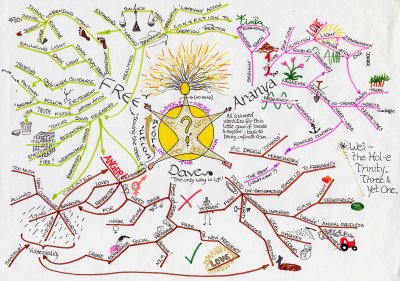Map Your Mind, Map Your Destiny
abracad, · Categories: self helpYour mind is an amazing entity with incredible potential, most of which remains unused. This article describes mind-mapping, a powerful technique for understanding what's really going on beneath your mind's hood. To learn more about understanding and using the full power of your mind, see Real Mind Power Secrets.
A mind map is essentially a graphical representation of concepts (usually starting from a central concept) and the relationships between them. The non-linearity of mind maps (compared to prose or lists) reflects the brain's internal representation of knowledge thus providing a more accurate model of mental function.
Popular psychology author Tony Buzan claims to have invented mind mapping when, as a student, he was looking for some books to aid his study effectiveness and found there were none. Though similar organizational diagrams have existed for centuries, eg according to Wikipedia some of the earliest examples were developed by noted thinker Porphyry of Tyros in the 3rd century, Buzan's mind maps incorporate images and different colors to enhance their effectiveness. Learn more with Tony Buzan's Mind Map Book.
A simpler form of mind map (eg without color or imagery) is often called a spider diagram. These are still useful to gain an insight into the inner workings of one's mind.
Mind maps may be used for note making/taking (making notes includes something of one's own reflections whereas taking notes is merely recording the ideas of others) for study or business, enhancing self-knowledge, decision-making, project management, project (and life) planning and creative brainstorming. Mind mapping can be an individual or a group activity.
How to Mind Map
Having decided the topic you wish to explore take 5 minutes or so to clear your mind, thinking of nothing in particular. Your subconscious will begin working behind the scenes.
A mind map generally begins with the theme one wishes to explore. This is placed in the center of the page. Next, related concepts are added, branching out from the center, each of these then forms a sub-center from which further concepts radiate out. Sometimes themes will recur on different branches; these are joined by lines on the mind map.
Record everything that pops into consciousness, censor nothing. The idea is to get a concrete picture of everything you associate with the central theme.
Take a further break, 5 minutes or maybe even hours or days, before analysing your mind map and drawing conclusions. You may find some concepts / branches warrant mind maps of their own.
The above may be adapted to particular circumstance, eg making notes at a lecture or meeting.

Mind Map example
These days the mind mapping process can be carried out extremely efficiently using computer software such as Mindjet MindManager or Buzan's own iMindMap freeing your mind maps from the size of a page and allowing them to incorporate numerous data sources and to be edited on the fly. Electronic mind maps are easily shared and open to collaboration. See also FreeMind, free mind mapping software.
See also:
Filed in: self help


[...] helps to diagram your goals, working backwards from each long-term ideal through a series of intermediate sub-goals until you [...]